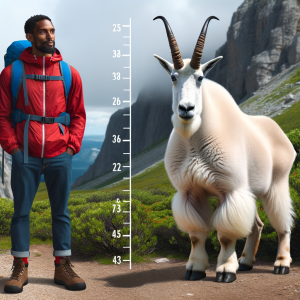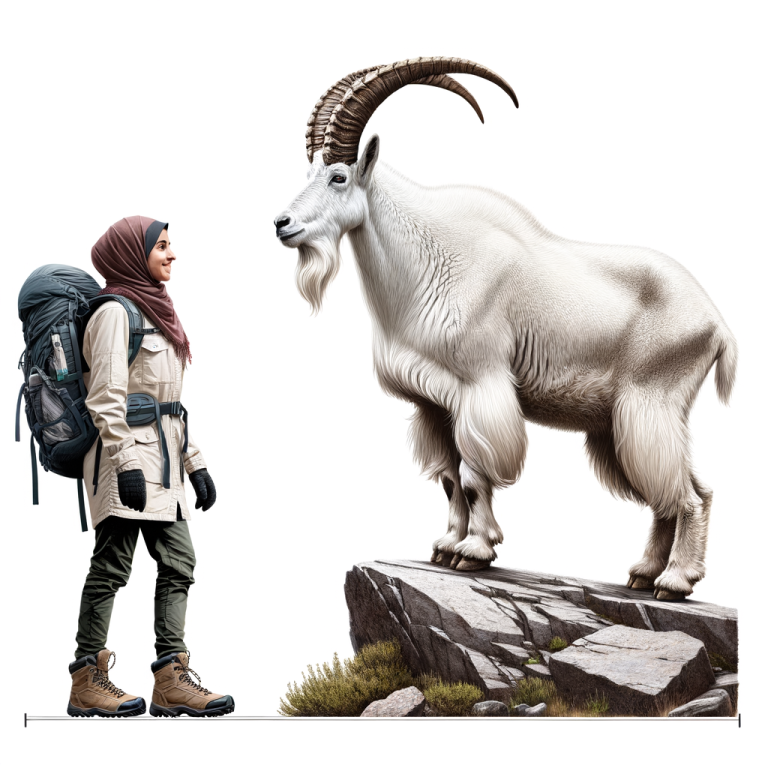Mountain Goat Compared to Human
Mountain goats are fascinating creatures, and in this article, I will explore their size, physical characteristics, behaviors, geographical locations, and interesting facts. Did you know that an average adult mountain goat stands at 3 feet 6 inches (1.07 meters) tall and weighs around 100-300 pounds (45-136 kilograms), while the average human is about 5 feet 9 inches (1.75 meters) tall and weighs 137 pounds (62 kilograms)? Let’s dive into the details and see how these differences shape their lives.
Discover the Surprising Similarities and Differences Between Mountain Goats and Humans
Find out how the weight and height of mountain goats compare to those of humans, and be amazed by the fascinating insights into these incredible creatures.
Size Comparison
When comparing the average height and weight of a mountain goat to that of a human, it becomes evident that mountain goats are significantly smaller in size. On average, a mountain goat stands at 3 feet tall at the shoulder and weighs around 100-300 pounds, while the average human stands at 5.5 feet tall and weighs around 137-187 pounds. This stark contrast in size is further highlighted when considering the physical dimensions of both species.
Comparison of Size Difference
The size difference between a mountain goat and a human is quite substantial. Mountain goats are much shorter and stockier in build compared to humans, with their compact bodies and muscular frames allowing them to navigate steep and rugged terrain with ease. In contrast, humans have a more elongated and upright posture, suited for walking on flat ground.
Physical Characteristics
Mountain goats are known for their impressive physical features, which contribute to their unique size and appearance compared to humans. Here are some key characteristics:
- Thick, shaggy white coat for insulation in harsh mountain environments
- Padded, concave hooves for gripping steep and rocky terrain
- Powerful shoulder and neck muscles for climbing and navigating rugged landscapes
- Short, sharp horns used for defense and establishing dominance within their herd
These physical attributes enable mountain goats to thrive in their natural habitat, allowing them to traverse steep cliffs and rocky outcrops with ease. In contrast, humans lack these specialized features, making it challenging for us to navigate such rugged terrain.
Behavioral Differences
Mountain Goat Behavior
Mountain goats are known for their unique behavioral traits that set them apart from humans and other animals. Understanding these behaviors can provide insight into the adaptability and survival strategies of mountain goats in their natural habitat.
Comparison of Behaviors
When comparing the behaviors of mountain goats to humans, several distinct differences become apparent. These differences include:
1. Social Structure
– Mountain goats typically live in herds, while humans tend to form more complex social structures within communities and families.
– Mountain goats exhibit hierarchical behavior within their herds, with dominant individuals asserting their authority, whereas humans have more egalitarian social structures.
2. Movement and Agility
– Mountain goats are incredibly agile and adept at navigating steep and rocky terrain, using their specialized hooves and muscular bodies to climb and leap with ease.
– Humans, while capable of hiking and climbing, do not possess the same level of agility and are more reliant on tools and equipment for traversing challenging landscapes.
3. Foraging and Feeding
– Mountain goats are herbivores, primarily feeding on grasses, herbs, and shrubs found in their alpine habitats.
– Humans have a much broader and varied diet, often relying on agriculture and domesticated animals for sustenance.
Unique Behaviors of Mountain Goats
In addition to the differences in behavior between mountain goats and humans, there are several unique behaviors exhibited by mountain goats that are worth noting:
– “Salt-seeking” behavior: Mountain goats are known to seek out salt licks and mineral deposits, often traveling long distances to satisfy this dietary need.
– Climbing and jumping: Mountain goats are adept climbers and jumpers, using their specialized hooves and muscular bodies to navigate steep and rugged terrain with ease.
– Seasonal migrations: Mountain goats exhibit seasonal migrations, moving to lower elevations in the winter and returning to higher elevations in the summer to take advantage of optimal foraging conditions.
Understanding these behavioral differences and unique traits of mountain goats provides valuable insight into their adaptation to their natural environment and enhances our appreciation for these remarkable animals.
Geographical Locations
Mountain goats are primarily found in North America, inhabiting mountainous regions such as the Rocky Mountains, the Cascade Range, and the Sierra Nevada. These rugged and steep terrains provide the ideal habitat for mountain goats, allowing them to thrive in areas that are challenging for humans to access.
Comparison of Habitats
While mountain goats prefer high-altitude environments with rocky cliffs and alpine meadows, humans are commonly found in a variety of geographical locations, including urban areas, plains, and lowland forests. The contrast in preferred habitats between mountain goats and humans highlights their distinct adaptability to different environments.
 Facts and Figures
Facts and Figures
Mountain Goat Compared to Human Naturally
In this section, we will delve into some interesting facts and figures about mountain goats, highlighting their unique characteristics and behaviors compared to humans.
A. Presentation of interesting facts about mountain goats
– Mountain goats are known for their incredible agility, able to navigate steep and rocky terrain with ease.
– These animals have specialized hooves with a hard outer shell and soft inner pad, providing them with exceptional grip on rugged surfaces.
– The impressive horns of mountain goats can reach lengths of up to 18 inches (45.7 cm) and are used for defense and dominance within their social hierarchy.
B. Use of html codes to highlight the most important facts
– The mountain goat’s ability to thrive in high-altitude environments, such as the Rocky Mountains and the Cascade Range, is a testament to their remarkable adaptability.
– These animals are herbivores, primarily feeding on grasses, herbs, and shrubs found in their mountainous habitats.
– Mountain goats are well-equipped for cold climates, with a thick, woolly coat that provides insulation against harsh weather conditions.
C. Incorporation of scientific and technical terms with clear explanations
– The scientific name for the mountain goat is Oreamnos americanus, derived from Greek words meaning “mountain” and “lamb,” reflecting their habitat and appearance.
– The unique behavior of “locomotory grooming,” where mountain goats use their horns to scratch hard-to-reach areas, showcases their resourcefulness in maintaining hygiene.
By presenting these facts and figures, we aim to provide a comprehensive understanding of the remarkable adaptations and behaviors of mountain goats compared to humans, highlighting their distinct characteristics and the fascinating nature of these resilient animals.
Conclusion
In conclusion, the comparison between mountain goats and humans highlights the fascinating differences between these two species. From their physical characteristics to their behavioral traits, mountain goats and humans are distinctly unique in their own ways. The purpose of this article has been to provide an informative and educational overview of mountain goats, encouraging readers to further explore this intriguing topic.
By emphasizing specific characteristics, behaviors, geographical locations, and facts, this article aims to offer a comprehensive understanding of mountain goats and their natural habitat. The use of clear and straightforward language, along with the incorporation of scientific and technical terms with clear explanations, ensures that readers can easily grasp the information presented.
Overall, this well-structured and informative article serves as a comprehensive guide about mountain goats, catering to a broad audience interested in learning about these fascinating creatures. It is our hope that readers will find this article engaging and valuable in expanding their knowledge about mountain goats and the unique aspects of their existence.


Comments are closed.